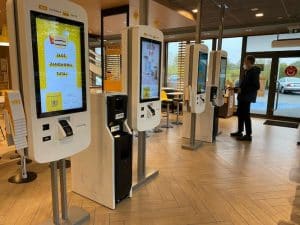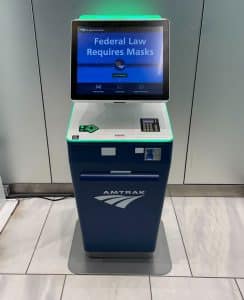Kiosk Meaning
What does the word kiosk mean? It meant one thing 600 years ago.
1620s, “kind of open pavilion” (made of light wood, etc., often supported by pillars), from French kiosque (17c.), which is (along with German and Polish kiosk) from Turkish koshk, kiöshk “pavilion, summer house,” from Persian kushk “palace, villa; pavilion, portico.” They were introduced in Western Europe 17c. as ornaments in gardens and parks. Later of street newsstands (1865), on some resemblance of shape, a sense perhaps originally in French. Modern sense has been influenced by British telephone kiosk (1928).
Wikipedia describes it in the Interactive Kiosk page.
In the modern computerized world the word kiosk means something else altogether.
Characteristics:
- Generally it is unattended
- It is interactive (usually via touchscreen)
- Usually connected to the internet
- Supports payments optionally
- Different form factors are:
- Standup pedestal
- counter top
- wall-mount
- outdoor
- Screen size can vary between 7″ displays for bike rental to big dual sided 55s like the Volta EV charging
And then there are RMUs or Remote Merchandising Units. Think of the Bose headphone “kiosk” at the airport (or Verizon). These are more akin to “store fixtures” and point-of-purchase fixtures that include POS options and typically a person to help you decide.
What the word Kiosk means
Here are some of the “kiosk meaning” for the modern-day kiosk. Kiosks today are very much different than those from years ago with photo kiosks from Kodak and ATM machines. Self-check-in from the major airlines (we used to work for Northwest Airlines ourselves and piloted check-in in the Ford Commissary in Detroit.
They are self-service kiosks, usually electronic, and can be found in all walks of life. The form factor ranges from a mobile device to a tablet to a larger enclosures (usually metal but also plastic and wood). They are transactional with devices and they are informational only.
- In malls, events, tradeshows and other locations you have the RMU, which is a Remote Merchandising Unit. Example manufacturer could be Ikoniq (main business being RMUs).
- Airline Check-In Kiosks
- ATM Machines
- Electronic kiosks
- Internet Cafes
- POS Terminals
- Food Order Kiosk
- Gaming Kiosks
- Parking kiosks
- Outdoor kiosks
- Hoteling
- Information Kiosks terminals
- Interactive Digital Signage
- Immigration and Security Kiosks
- Gift card kiosks
- Retail kiosk
- Gift Registry kiosk
- Tablet kiosk
- Vending
- Pharmacy kiosk
- Lockers
- Charging kiosks
- Coin Kiosks
- Music, Movie and Media download kiosks
- DVD kiosks
- Hospitality
- Healthcare
- Telemedicine and Telehealth
- Marijuana & Cannabis
- Photo Kiosk
- Prison kiosk
- Social kiosks
- Kiosk Software
- Survey Kiosks
- Wayfinding kiosk
- Wine Kiosks
Kiosk Definition From Wikipedia
Kiosk Meaning – An interactive kiosk is a computer terminal featuring specialized hardware and software that provides access to information and applications for communication, commerce, entertainment, or education.
Early interactive kiosks sometimes resembled telephone booths, but have been embraced by retail, food service and hospitality to improve customer service. Interactive kiosks are typically placed in high foot traffic settings such as shops, hotel lobbies or airports.
Integration of technology allows kiosks to perform a wide range of functions, evolving into self-service kiosks. For example, kiosks may enable users to order from a shop’s catalogue when items are not in stock, check out a library book, look up information about products, issue a hotel key card, enter a public utility bill account number in order to perform an online transaction, or collect cash in exchange for merchandise. Customised components such as coin hoppers, bill acceptors, card readers and thermal printers enable kiosks to meet the owner’s specialised needs.
Where are Kiosks Used
It is estimated that over 1,200,000 kiosk terminals exist in the U.S. and Canada alone.
Groups who use kiosks in their business environment include: Delta Airlines, United Airlines, JetBlue Airways, GTAA, Future Shop, The Home Depot, Target Corporation, and Wal-Mart.
2020 Update — we did a quick calculation of just restaurants and restaurant kiosks.
There isn’t a fixed number but if I estimated locations for majors in the U.S.
- burger = 50,000 (McDonalds 14K)
- Mexican = 10,000
- specialty = 5000
- sandwich = 35000 (subway 27K)
- casual dining = 5000 (applebees has 1700)
- beverage/snack = 35000
- chicken = 15000
- pizza = 27000
- family dining = 9000
- bakery = 4000
- That’s around 125,000 factoring the majors
- Figure they account for 70%
- New total around 170,000
- Figure McD has 38,000 in the world
Extrapolated out worldwide approaching 500,000Figure COVID closed 20% of thoseMy guess would be close to 2M order stationsAccelerants would be chains like Chili’s and others with an order kiosk at every table.Streetside restaurants in Lagos are unlikely to utilize kiosksIndustry Trends
Just in the Restaurant industry in 2020
28 mergers and acquisitions in the restaurant industry in 2020
Excerpt:
The $11.3 billion Inspire/Dunkin’ deal was certainly the talk of the finance world. The deal was completed on Dec. 15. and now gives Inspire Brands an entrance into the breakfast segment, taking the Dunkin’ and Baskin-Robbins brands private.
Another notable acquisition was the growing brand BurgerFi, which was acquired by OPES Acquisition Corp. and announced it would be begin being traded on the Nasdaq on Dec. 17 under the ticker BFI. The company was renamed BurgerFi International Inc.
And this year wouldn’t be complete without speaking of third-party delivery companies.
With demand for delivery spiking after restaurant dining rooms were closed across the country, Grubhub, Uber Eats, and Postmates jockeyed for position with consolidation. Grubhub was acquired by Just Eat Takeaway for $7.3 billion in June, and Uber purchased Postmates for $2.65 billion in July. DoorDash, meanwhile, became a publicly traded company in December.


